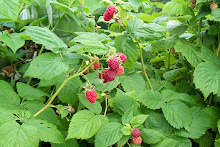 I first started canning tomatoes back in the 80's. I was living in a suburb and a Farmer's Market had just opened. I noticed that at many stalls there would be huge boxes of over-ripe tomatoes growers were selling for next to nothing. That's when I decided to learn about canning tomatoes. I was thrilled with the results. The best part was I controlled exactly what went into the tomatoes, or more accurately, what didn't. No salt, no sugar, no extra water or flavorings. And I thought they tasted better, but that was probably just because I made them. Then I moved to the city, got a "real job" and canning tomatoes fell to the wayside.
I first started canning tomatoes back in the 80's. I was living in a suburb and a Farmer's Market had just opened. I noticed that at many stalls there would be huge boxes of over-ripe tomatoes growers were selling for next to nothing. That's when I decided to learn about canning tomatoes. I was thrilled with the results. The best part was I controlled exactly what went into the tomatoes, or more accurately, what didn't. No salt, no sugar, no extra water or flavorings. And I thought they tasted better, but that was probably just because I made them. Then I moved to the city, got a "real job" and canning tomatoes fell to the wayside. Now, having a garden of my own, canning tomatoes is possible again. Rooting out all my canning supplies, I was surprised how well the canner and bottles had survived the years and countless moves. The biggest challenge was actually finding the equipment in a sea of rather dusty and worn boxes. Believe it or not, there were boxes that had never been opened in two or three moves.
Canning tomatoes is easy. This year I grew mostly Roma tomatoes, they are also known as Italian or plum tomatoes. They are the easiest to proccess because they peel so fast and in one clean step. Dip them in boiling water for about 30 seconds, drop 'em in cold water, fish 'em out, cut off the top, squeeze the bottom and voila, the tomato slips out with a plop and no mess. Their size and shape are perfect for canning, very little cutting or chopping is required.
 So here they are all skinned and ready for the jars. Recommendations for canning have changed in the last 20 years. Now they say to cover the jars an inch over the top with water in the canner, when I first did them, the water just went up to the bottle necks. As well, lemon juice is added to the bottles before putting the tomatoes in. Apparently, tomatoes have less acidity in them then they used to (unlike some people I know who tend to get more acidic as they grow older). Back in the day, I always cold packed them. I did try hot packing them but it seemed like more work and time for no difference in the end anyways.
So here they are all skinned and ready for the jars. Recommendations for canning have changed in the last 20 years. Now they say to cover the jars an inch over the top with water in the canner, when I first did them, the water just went up to the bottle necks. As well, lemon juice is added to the bottles before putting the tomatoes in. Apparently, tomatoes have less acidity in them then they used to (unlike some people I know who tend to get more acidic as they grow older). Back in the day, I always cold packed them. I did try hot packing them but it seemed like more work and time for no difference in the end anyways.The biggest challenge are getting the tomatoes ripe. Our growing season is so short here, that by the time the first frost threatens, most of the tomatoes are just thinking of turning red. So I put them in boxes, layed between sheets of newspaper. I'm supposed to wrap each and every tomato in newspaper but what a pain when trying to find the ripe ones! A lot of unwrapping and wrapping goes on and by the time I get through the two hundred or so tomatoes, chances are a few more have ripened! The layers work pretty well. I do add a couple of apples to the boxes because it's supposed to help with the ripening. Anyhow, it doesn't take too long for them to ripe. What is really nice is that they don't all ripen at the same rate so I do a batch every now and then instead of having way too many to do all at once.
The best thing is that the canned tomatoes last from season to season. By the time I use the last jar of my tomatoes, new jars are all ready to take their place.

